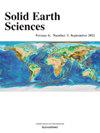Impact of extremely low porosity on geothermal gradient and fluid migration in gas hydrate-bearing layers: A case study of South Shetland Islands, Antarctic Peninsula
IF 2
4区 地球科学
Q3 GEOSCIENCES, MULTIDISCIPLINARY
引用次数: 0
Abstract
Numerical fluid flow models were employed for the first time to study gas hydrates in South Shetland Islands, Antarctic Peninsula. The complexity of its geology, added to the remote and environmentally sensitive characteristics, makes it a very unique natural laboratory, where studying processes that could influence gas hydrate stabilityremains highly challenging. Based on seismic data, a marine subsurface model was created and fluid flow simulations carried out with ANSYS Fluent. Key inputs like sediment thickness, in-situ faults, and fractures, and water column dimensions were obtained from seismic sections. The same value of thermal and physical rock properties was assumed for each geological unit; the mesh structure was developed using triangular discretization. Four numerical models were constructed to investigate how variations in porosity, particularly under extremely low-porosity conditions, might affect thermal and fluid flow behavior within hydrate-bearing sediments. Porosity values of 0.01, 0.05, 0.1, and 0.2 were systematically applied to represent the low-porosity regimes. The results highlight that, especially at extremely low porosity, porosity together with fault density and seafloor bathymetry can strongly shape the distribution of heat transfer and fluid migration patterns. While the models do not directly simulate gas hydrate dissolution, the findings suggest that localized thermal anomalies and structural complexities could potentially create conditions favorable to destabilization processes. These insights contribute to a better understanding of the geophysical and hydrodynamic factors that may influence gas hydrate systems in complex and sensitive geological settings.
极低孔隙度对含天然气水合物地层地温梯度和流体运移的影响——以南极半岛南设得兰群岛为例
首次采用数值流体流动模型对南极半岛南设得兰群岛天然气水合物进行了研究。其地质的复杂性,加上偏远和环境敏感的特点,使其成为一个非常独特的自然实验室,在这里,研究可能影响天然气水合物稳定性的过程仍然极具挑战性。基于地震资料,建立海洋地下模型,利用ANSYS Fluent软件进行流体流动模拟。从地震剖面中获得沉积物厚度、原位断层和裂缝以及水柱尺寸等关键输入。假设每个地质单元的岩石热物理性质值相同;采用三角离散法建立网格结构。建立了四个数值模型来研究孔隙度的变化,特别是在极低孔隙度条件下,如何影响含水合物沉积物中的热和流体流动行为。孔隙度值分别为0.01、0.05、0.1和0.2,系统地代表了低孔隙度区。结果表明,特别是在极低孔隙度下,孔隙度、断层密度和海底水深对传热和流体运移模式的分布具有重要影响。虽然这些模型不能直接模拟天然气水合物的溶解,但研究结果表明,局部的热异常和结构复杂性可能为不稳定过程创造有利条件。这些见解有助于更好地理解在复杂和敏感的地质环境中可能影响天然气水合物系统的地球物理和水动力因素。
本文章由计算机程序翻译,如有差异,请以英文原文为准。
求助全文
约1分钟内获得全文
求助全文
来源期刊

Solid Earth Sciences
GEOSCIENCES, MULTIDISCIPLINARY-
CiteScore
3.60
自引率
5.00%
发文量
20
审稿时长
103 days
 求助内容:
求助内容: 应助结果提醒方式:
应助结果提醒方式:


